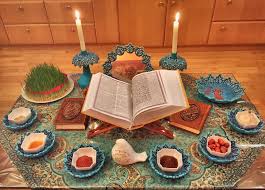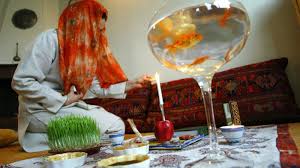 Nowruz (starts 20 March) is the national New Year festivity celebrated in Iran, Afghanistan, and the Kurdish regions of Iraq, Turkey and Syria, and throughout Central Asia. Described by 11th-century Persian astronomer and poet Omar Khayyam as “the renewal of the world”, Nowruz dates back thousands of years. It is not known exactly how far back Nowruz goes, but current estimates are that it is at least 3,000 years old, when the Persian empire extended beyond the borders of modern Iran.
Nowruz (starts 20 March) is the national New Year festivity celebrated in Iran, Afghanistan, and the Kurdish regions of Iraq, Turkey and Syria, and throughout Central Asia. Described by 11th-century Persian astronomer and poet Omar Khayyam as “the renewal of the world”, Nowruz dates back thousands of years. It is not known exactly how far back Nowruz goes, but current estimates are that it is at least 3,000 years old, when the Persian empire extended beyond the borders of modern Iran.
It begins at the spring equinox – the moment when the sun crosses the equator and day and night are of equal length. Usually, this is between 19-21 March, depending on astronomical calculations. This year, it is due to begin on 20 March a little after 7am Tehran local time.
It is a springtime celebration whose activities symbolise rebirth and the link between humans and nature. The Iranian poet Saadi (1210-1291) wrote: “Awaken, the morning Nowruz breeze is showering the garden with flowers.”
While the two-week celebrations centre on seeing relatives, picnicking, travelling, and eating traditional food, Nowruz itself – which is Farsi for New Day – is steeped in ancient myths and fiction, as well as traditions and symbols. A commonality across the Central Asian countries is the 24-hour preparation of sumalak, a thick pudding made from wheatgrass, as women sing folk songs while stirring huge pots.
Preparations for Nowruz celebrations in Iran begin weeks before the start of spring, including house-cleaning (khaneh takani). Families also grow sabzeh (wheat, barley, mung bean or lentils) in a dish.
When the greens sprout after a couple of weeks, the dish is placed on the Haft-seen table, which is the focus of Nowruz observance. It is joined by six other symbolic items which start with the Persian letter “seen” or S. That makes seven, a sacred number in Zoroastrianism. They include:
- seeb (apples) – symbol of health and beauty
- senjed (dried oleaster berries) – wisdom and rebirth
- samanu (wheat pudding) – strength/justice
- somaq (sumac) – patience
- serkeh (vinegar) – age/patience
- seer (garlic) – cleansing of body and environment
 The Haft-seen spread also includes other items such as a mirror, symbolising reflection; coloured eggs, for fertility; and goldfish in a bowl, which represent life.
The Haft-seen spread also includes other items such as a mirror, symbolising reflection; coloured eggs, for fertility; and goldfish in a bowl, which represent life.
There is usually also a book by the Persian poet Hafez (1315-1390), or the Quran. They reflect Nowruz’s power to blend its ancient roots with more recent religious and cultural traditions.
The festivities end 13 days after the New Year with Sizdeh Bedar, which can be translated as either “getting rid of 13” (a symbol of bad luck), or “to hit the road”.
